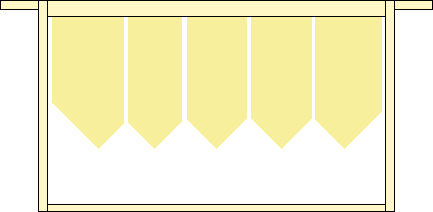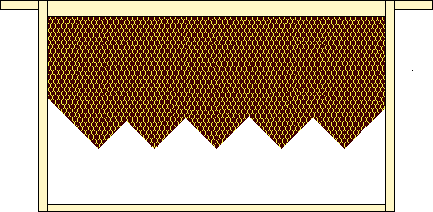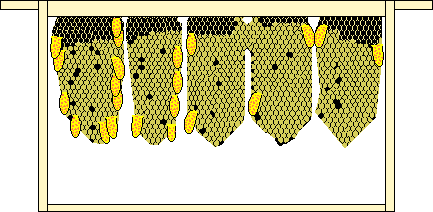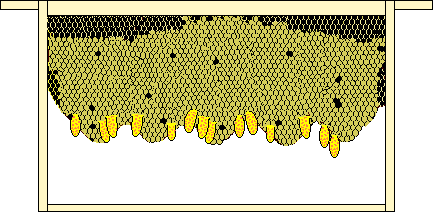
Queen Cell Starting Methods
There are many methods of inducing honey bees to produce queencells by utilising the natural impulses inherent in the bees themselves.
Swarming Impulse
Skep beekeeping would seem to have propagated the swarming impulse at the expense of the others. It has also been common for beekeepers to use swarm cells to make nuclei with or to re-queen stocks. There is a difference between using swarm cells and using the swarming impulse in a deliberate queen rearing system.

Miller method... this involves a comb that has a zig-zag edge at the bottom of the comb portion. The comb can be produced from scratch by mounting triangular portions of foundation in a frame to produce the zig-zag effect. The gaps between the strips will be enlarged in a ragged fashion and also utilised for queencells. The hive that the frame will be placed in should be level in order that the strips of foundation can hang vertically and
not get bridged across to the flanking frames.

Or a used comb can be cut to shape with a sharp knife. The comb will be recycled
anyway so it matters little, which way is actually chosen. A comb that has only been bred
in for a few cycles will cut easier and with less tearing.

Alley Method... also known as the 'Alley Plan' whereby a strip of cells
containing one day old larvae, is removed from a comb and placed with the cells pointing downwards and every 2nd and 3rd larva is destroyed, leaving adequate spacing for queencells to be started and finished without surgical skills being needed to separate the sealed cells.

The queencells in this illustration are exaggerated in size, but the positions that they are shown in were taken from an actual comb.

The queencells in this illustration are also exaggerated in size, but the illustration has been synthesised rather than depicting an actual ragged old comb.
Supersedure Impulse
This is the most promising feature to be cultivated for future bee improvement as it may help redress the balance. Skep beekeeping methods tend to select for swarming propensity simply due to constantly re-hiving early swarms (swarm of bees in May Etc. Etc.). Thus many of the strains of bee we have today are derived from these "swarmy" stocks.
Emergency Impulse
A last resort for the bees, and should be considered so by the beekeeper. The practice of splitting or artificial swarming utilises this impulse which may be OK for the odd increase or re-queening, but should not be considered seriously for a deliberate breeding program.
Swarm Box Methods
There are a number of slightly different methods that use this technique. I will detail them all when time permits.
One such method uses a
special Lid that will fit one of my purpose designed swarm boxes that will allow insertion of grafted frames or
purpose built frames of cell punches (as recommended by Roger Patterson), without any leakage of bees from the body of the box.



